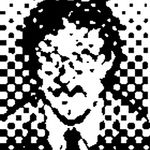- Home
- Illustrator
- Discussions
- Re: Problem in Tracing Seamless Pattern in Illust...
- Re: Problem in Tracing Seamless Pattern in Illust...
Copy link to clipboard
Copied
I had some seamless patterns in jpeg format.I brought it in illustrator and auto traced it. But when i tried to use it as a swatch it is not seamless rather it shows tiny gap between the edges. I’ve tried resizing it other remedial actions but no improvements. Please check it I am attatching original jpeg pattern, traced and exported file from illustrator showing problematic pattern.
 2 Correct answers
2 Correct answers
This art is so easy to draw, forget about tracing because drawing by hand you will have:
- less bumpy jagged art
- less point so the file is smaller and prints quicker
- cleaner art for editing and making alt versions
Then set up for example a 300 pixel black square. Set your cursor key distance to 300 pixels. Then do your art around edges first.
then do the middle
then copy the black square, select all, paste in fron, select all then mask
Then create your pateren, and set the repeat to 300 x 300.
...Image Trace in Illustrator is not 100% precise. For a repeating pattern, the pattern tile must be a perfect square or rectangle. When you trace, the edges or corners are likely no longer perfectly straight.
Since you have many patterns, you might consider leaving the pattern tile as a bitmap without tracing it. Your bitmap has nice straight edges and corners and I don't think there will be any gaps in the pattern repeats.
Explore related tutorials & articles
Copy link to clipboard
Copied
This art is so easy to draw, forget about tracing because drawing by hand you will have:
- less bumpy jagged art
- less point so the file is smaller and prints quicker
- cleaner art for editing and making alt versions
Then set up for example a 300 pixel black square. Set your cursor key distance to 300 pixels. Then do your art around edges first.
then do the middle
then copy the black square, select all, paste in fron, select all then mask
Then create your pateren, and set the repeat to 300 x 300.
Copy link to clipboard
Copied
Actually it is not just about this art , I have many old seamless patterns in .jpeg format. I thought I should convert them to vectors.But I am facing the same issue with every pattern. Can you find what is the problem.
Copy link to clipboard
Copied
Image Trace in Illustrator is not 100% precise. For a repeating pattern, the pattern tile must be a perfect square or rectangle. When you trace, the edges or corners are likely no longer perfectly straight.
Since you have many patterns, you might consider leaving the pattern tile as a bitmap without tracing it. Your bitmap has nice straight edges and corners and I don't think there will be any gaps in the pattern repeats.
Copy link to clipboard
Copied
Why do you want to vectorize them?
Copy link to clipboard
Copied
To get some more freedom with customizations and resolution.
Copy link to clipboard
Copied
Does the tiny gap disappear when you uncheck the smoothing option in Preferences > General?
Copy link to clipboard
Copied
I have no problem with the big 3000 pixel file you showed here (emoji pattern_00068.jpg)
What are your tracing settings? Your EPS looks horrible.
How do you export? Art or Type optimized anti aliasing?
If you trace the high res file, you can see some small bumps, but no lines.
Copy link to clipboard
Copied
aakash,
Whichever other choices you make, I believe it is always best to minimize the amount/complexity of artwork crossing the edges, especially in the corners, and if needed to minimize the visibility of possibly misalignment.
At least for the pattern shown it is possible to choose artworkless edges, whole faces inside and simple black area edges: you can move the horizontal edge down (or up) from the face at the crossing to be a bit above the next one crossed by the vertical edge; and you can move the vertical edge right (or left) to be just to the right of the next one crossed by the horizontal edge.
A simple way to optimize the (non) crossing can be to move a long vertical line horizontally and a long horizontal line vertically and simply choose from your findings; you can use the arrows (in the relevant areas). Remember to choose the positions and sizes to fit the unit and the pupose, with whole/integer values of all corners of both artwork and Artboard (points/pixel values for screen/web use).
Copy link to clipboard
Copied
These are the Image Trace settings I used and there were no gaps between tiles.
Find more inspiration, events, and resources on the new Adobe Community
Explore Now








